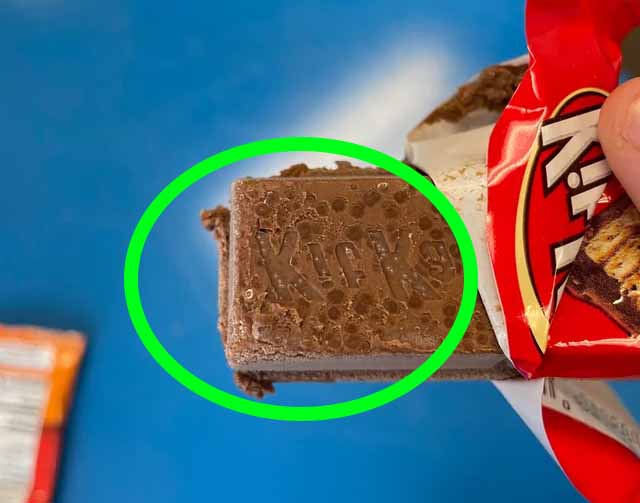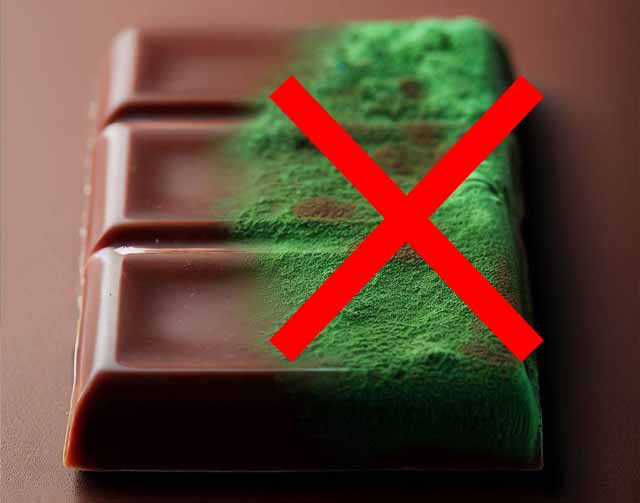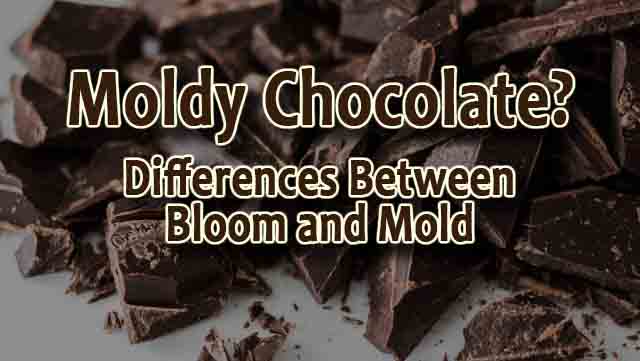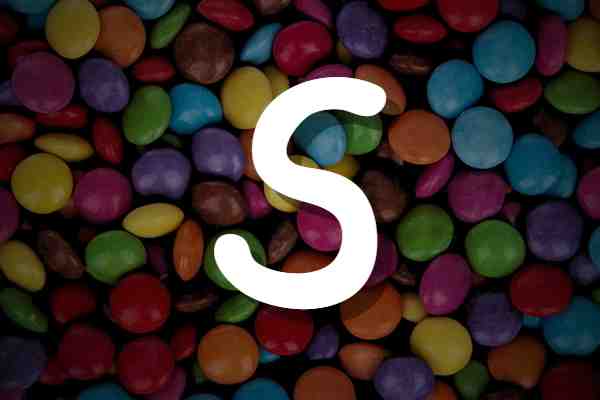Chocolate that has not been stored in proper conditions will usually end up with a white, chalky surface that looks similar to mold. Chocolate that has been stored above 80 degrees Fahrenheit or in a place where there is a lot of moisture can develop whitish streaks called “bloom.”
There are two forms of chocolate bloom: sugar and fat bloom. Chocolate with either form of bloom is perfectly fine and safe to eat; it just looks unappetizing.
However, it is highly unlikely for chocolate to get moldy. Moist and warm conditions are ideal for mold growth. In chocolate, there is a high cocoa content and low moisture. The mold that grows on chocolate is typically a greenish color if any grows at all. This can happen when chocolate is left unsealed in a dark and damp condition.
Don’t worry, most chocolates that have a chalky surface are caused by bloom, which is safe for consumption. Unless the chocolate has been stored improperly, it is quite rare to have moldy chocolate. Even if mold and bloom appears in warm and humid conditions, it is more common for blooming to occur in chocolates.
Long story short, if you see any green, toss it out.
Difference Between Mold and Bloom on Chocolate?
It is common to assume that the white chalky surface of chocolate is mold. Improper storage or age can cause separation of ingredients.

In the rare instance of mold on chocolate, it is typically a green mold growth. If you see any green growing on the chocolate, toss it out. This usually never happens as chocolates are usually packaged and sealed.

White mold looks fuzzy or webby and grows above the surface of foods. The chalky streaks that sometimes appear on chocolates are not fuzzy.
Sugar and fat bloom are common occurrences in chocolate especially if left unsealed. The outside of a chocolate bar is more likely to be discolored from bloom than from mold.
What is Chocolate Bloom?
Typically, chocolate bloom is due to milk and fat ingredients separating due to age, heat, or other improper storage conditions.
When chocolate is not tempered correctly, blooms in the form of sugar and fat rises to the surface of the chocolate as a streaky, white off-color. Bloom only affects the chocolate visually and has no effect on the taste.
While the taste may be the same, sometimes blooming can cause the chocolate to have a grainy texture.
Chocolate blooming is common in chocolates that are not fully tempered.
Sugar Bloom
Excess humidity is the primary cause of sugar bloom. Condensation on chocolate causes sugar to dissolve and recrystallize on the surface as a chalky white appearance.
Fat Bloom
Typically caused when chocolate is exposed to warm or high temperatures. Fat bloom can also be caused by an improper tempering process. Make sure to use a thermometer when tempering chocolates as the temperature range is precise.
The cocoa butter separates from the other ingredients under warm conditions. The fat then rises to the surface of the chocolate. It then settles into a chalky, white color on the exterior.
Is Chocolate Bloom Safe to Eat?
Yes, the effects of bloom are only visual (sometimes accompanied by a grainy texture). Chocolate with sugar or fat bloom is safe for consumption.
So if you are gifting chocolate that has bloomed at the last second, it’s not the end of the world. The texture of the chocolate might be a little off but it is still chocolate.
The grainy mouthfeel will come from the cocoa fats separating from other ingredients.
Stale chocolate, on the other hand, should probably be tossed out.
How to Stop Chocolate From Blooming
If you are pouring chocolate into molds, make sure the mold is completely dry before using. Any water droplets on the chocolate will make it a lot easier for sugar bloom to occur. This also applies to any tools you may be using; make sure they are clean and dry.
If this is chocolate you prepared, it is as simple as retempering by using seed chocolate that is not bloomed.
When storing the chocolates, make sure of two things: low humidity and cool temperatures. Remember heat and moisture can cause chocolate bloom to occur.
Related Questions
Can You Store Chocolate in the Fridge?
Ideally, the best conditions for storing chocolate are cool and dry.
If storing chocolates in the refrigerator, it is important to seal in an airtight container. While fridges do have a constantly cool temperature, there is still humidity and moisture to worry about. Even in an airtight container, there can still be some condensation on the surface of chocolates.
Not only that, chocolates may absorb the odors of foods nearby if left unsealed.
Storing chocolate in the fridge will not temper the chocolates. Untempered chocolates will eventually melt or bloom when brought back down to room temperatures. When removing chocolate from the fridge, let the chocolate acclimate to room temperatures





